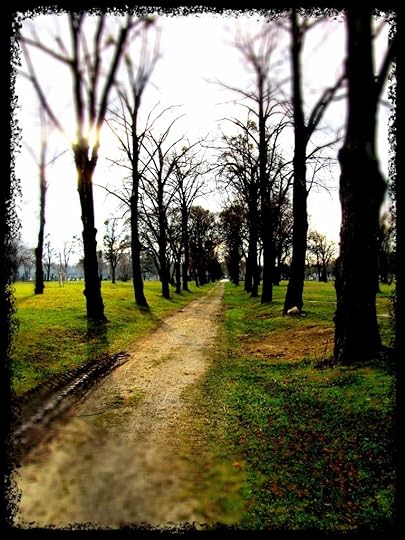Christine Valters Paintner's Blog, page 127
August 2, 2015
Abbey Sabbatical
The Abbey is going to take a sabbatical from the weekly newsletters through August. Look for us back in your in-box in early September.
Please note: If you subscribe to the daily nourishment, you will still receive those Monday-Saturday during this time.
Blessings on the Celtic Feast of Lughnasa! To join us in honoring the rhythms of the Celtic wheel of the year, consider registering for Sacred Seasons which is a yearlong journey including reflections, poems, songs, dance, and more for each of the eight thresholds of the natural cycles. You can work through the materials year after year.
The post Abbey Sabbatical appeared first on Abbey of the Arts.
August 1, 2015
Giving Up a Too-Small God
Dearest monks, artists, and pilgrims,
Another reflection from the Abbey archives for you on expanding our understanding of the divine:
Let mystery have its place in you; do not be always turning up your whole soil with the plowshare of self-examination, but leave a little fallow corner in your heart ready for any seed the winds may bring, and reserve a nook of shadow for the passing bird; keep a place in your heart for the unexpected guests, an altar for an unknown God.
— from Amiel's Journal, translated by Mrs. Humphrey Ward
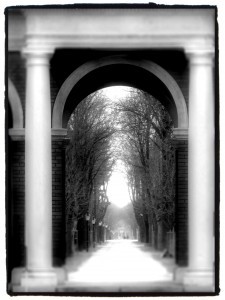 John Cassian, one of the ancient desert fathers, describes three renunciations he says are required of all of us on the spiritual journey. The first is our former way of life as we move closer to our heart's deep desires. The second is the inner practice of asceticism and letting go of our mindless thoughts. The third renunciation is to let go of our images of God—the idols we cling to so tightly—and to recognize that any image or pronouncement we can ever make about God is much to small to contain the divine. Even the word "God" is problematic because it carries with it so many interpretations and limits based on our cultural understandings.
John Cassian, one of the ancient desert fathers, describes three renunciations he says are required of all of us on the spiritual journey. The first is our former way of life as we move closer to our heart's deep desires. The second is the inner practice of asceticism and letting go of our mindless thoughts. The third renunciation is to let go of our images of God—the idols we cling to so tightly—and to recognize that any image or pronouncement we can ever make about God is much to small to contain the divine. Even the word "God" is problematic because it carries with it so many interpretations and limits based on our cultural understandings.
We live in an age when fundamentalism has emerged as an overwhelming force in religious consciousness. In times that are chaotic and uncertain, our human minds grasp for a sense of control. One of the ways we try to make sense of things is to engage in black and white thinking. Establishing clear rules for how the world works, and who is inside and outside of God's sphere, is a way of coping with this felt loss of an anchor or shared cultural sense of meaning.
The via negativa or apophatic way in Christian tradition, which means the way of unknowing, demands that we talk about God only in terms of negatives, or what God is not. It helps to cleanse us of our idols. Alan Jones, in his book Soul-Making, writes, "We can only say that God is both unknowable and inexhaustible." Humility is required. We are so attached to our ideas of who God is and how God works in the world. Ultimately, what the desert journey demands is that we let go of even this false idol and open ourselves to the God who is far more expansive than we can behold or imagine.
Letting go of our images of God can be terrifying. It is often the result of an experience of suffering in our lives, when our previous understanding is no longer adequate to give meaning to what has happened to us. When my mother died suddenly in my early thirties, I was thrust into the desert. All of my certainties about God and life were stripped away and I was left raw and frightened. Many people offered trite words and shallow comfort in my grief, they were not willing to sit with me in the darkness, but only hoped to rush me through to a place of light.
This is the mystical experience of the "dark night of the soul," when old convictions and conformities dissolve into nothingness and we are called to stand naked to the terror of the unknown. We must let the process move through us—one which is much greater than we can comprehend. We can never force our way back to the light. It is only in this place of absolute surrender that the new possibility can emerge. We don't just have one dark night in our lives, but again and again, as we are called to continue releasing the images we cling to so tightly.
Sheri Hostetler is a Mennonite poet whose poem "Instructions" begins, "Give up the world; give up self; finally, give up God." Her choice of words is certainly provocative and when I have read this poem in classes and on retreats, I encounter a wide range of reactions from a visible sigh of relief to the anxious confusion over whether I am proposing a kind of atheism.
In some ways I am, at least in the way that Christian mystic Simone Weil speaks about it. She tells us that "there are two atheisms of which one is a purification of the notion of God." This is the call of the desert elders: to let go, let go, let go, and let go some more, on every level of our lives, to everything we cling to, including, or especially our ideas about God. As soon as our human minds begin to fashion categories, we risk making idols of them.
The apophatic way isn't the only way we should approach the spiritual journey. As creatures who understand the world through our senses, we do need images to make sense of the world. I am someone who loves the arts for what they reveal about my inner symbolic life. Without images at all, we could border on a kind of nihilism.
The complement to the apophatic way, is the kataphatic, or way of images. Both of these paths—the way of images and the way of unknowing—are necessary for each other. When we become tempted to speak with too much assurance of how God works in the world, theapophatic way calls us back to a radical kind of humility. When we seek to engage in debate about the ways of God, the way of unknowing reminds us of the grace of silence, of questions over answers.
Meister Eckhart, a 13th century Christian mystic living in Germany, describes the practice of "gelassenheit," or non-attachment. Most contemplative traditions have a version of this concept and cultivate holding life and ideas with an open palm. This is a Buddhist precept as well. In yoga philosophy, aparigraha means non-grasping. We let go of how we would have life be, and welcome in the way things actually are, which includes acknowledging how little we know. Just like John of the Cross, Eckhart described God as "no-thing," meaning that God is not an object we can possess, but a reality that is far greater than our human comprehension.
We let go of who we are certain of God to be and cultivate an openness to the One who is far beyond the horizons of our imagining. In the Book of Job, God challenges Job's desire for understanding and asks "where were you when I laid the foundation of the earth?" God is never a set of concepts to be understood and grasped, but a relationship to encounter and engage. In this way, the spiritual life is always a journey and in process. We do not let go once and for all, but move through the layers of clinging in our lives until we are living more from our hearts than our minds. We do not arrive, but travel toward the horizon, realizing that it is always receding from our view.
With great and growing love,
Christine
Photo: Central Cemetery in Vienna, Austria by Christine Valters Paintner
The post Giving Up a Too-Small God appeared first on Abbey of the Arts.
July 30, 2015
Soul of a Pilgrim Summer Blog Book Tour: The Ancient Practice of Walking the Rounds
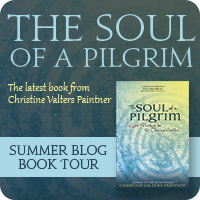 I continue my Soul of a Pilgrim summer blog book tour with a stop at Christine Sine’s blog with a guest post on walking the rounds as an ancient practice of pilgrimage in Ireland.
I continue my Soul of a Pilgrim summer blog book tour with a stop at Christine Sine’s blog with a guest post on walking the rounds as an ancient practice of pilgrimage in Ireland.
The tradition of pilgrimage in Ireland is an ancient ones. There are many trails and paths known to be sacred for hundreds, if not thousands of years.
One of the more ancient Irish practices of pilgrimage is the turas, which means to “walk the rounds” in holy places. Often there is a series of pilgrim stations – a series of cairns, a holy well, a cross, a chapel or sanctuary space – and each of these invites a circumambulation in a sunwise direction (clockwise), always in harmony with the rhythms of the universe. The number of rounds varies, but generally is either a single round at each place to pause, or the sacred number of three rounds, or a full seven or twelve rounds, which are also all holy numbers.
Click here to read the entire post>>
The post Soul of a Pilgrim Summer Blog Book Tour: The Ancient Practice of Walking the Rounds appeared first on Abbey of the Arts.
July 25, 2015
A Canine Horarium: Praying the Hours with My Dog (a love note)
Dearest monks, artists, and pilgrims,
As I deepen into this time of rejuvenation during my summer sabbatical, I offer you this post from deep in the Abbey archives back when we lived in Seattle and our sweet dog Winter was in our lives. Some of you have been journeying with us since that time. Winter wasn’t able to travel with us to Europe because she was part pit bull, but she went to live with friends of ours who adore her and where she has lots of room to romp and play with other dogs. Praying the Hours of the day is another kind of pilgrimage through time. These are some inspirations she offered to me during the time I was privileged to companion her:
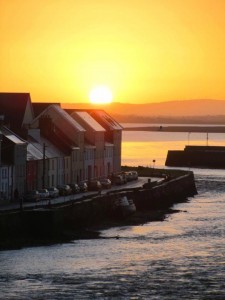 As a Benedictine oblate, I am committed to living as a monk in the world. For me, this means living contemplatively, savoring experience rather than rushing through it to the next thing, focusing on simplicity rather than consumption, and cultivating spaciousness rather than filling my days with endless activities.
As a Benedictine oblate, I am committed to living as a monk in the world. For me, this means living contemplatively, savoring experience rather than rushing through it to the next thing, focusing on simplicity rather than consumption, and cultivating spaciousness rather than filling my days with endless activities.
The natural world is my monk's cell, the place where I go to receive wisdom and guidance. My dogs have always been key sources of wisdom in my daily life; they have served as my spiritual directors inviting me into a much greater wisdom. Our current dog is named Winter. Her story is heartbreaking: She was abandoned on a farm and left to freeze to death. She survived but her puppies didn't. Welcoming her into our lives has brought me profound and unexpected gifts.
During the brief few months I have been without a canine companion in my life, I have often felt untethered. Something about the rhythms of a dog are grounding for me, especially as someone who is self-employed and often works several hours of the day at home.
In monastic tradition, praying the Hours is a fundamental part of moving through the day with presence and awareness. I offer you here the Horarium Winter leads me through.
Vigils: Night –The Hour of Sleeping, Dreaming, and Cherishing
My husband and I are asleep in our bed, Winter curled up in her own bed in the corner. Occasionally I awaken to remember a fragment of a dream and write it down. Sometimes in the dark quiet I hear Winter's legs twitching or muffled barking. I wonder if she is dreaming of chasing squirrels. Or I hear her and my husband breathing deeply and I cherish the presence of these two precious ones in my life.
Lauds: Dawn—The Hour of Awakening
I am not a morning person. This is the hour when I sometimes wish I could sleep in, but Winter will have none of that. She is ready to go out first thing and as the sun rises earlier and earlier as we near the summer solstice she calls me out of bed earlier as well. Some mornings I am gifted with a glimpse of the full moon setting or the glorious swathe of pink across the sky. In these moments I even find myself grateful to awaken with the dawn. I prepare my heart to receive the day ahead.
Terce: Morning—The Hour of Stretching
We return from our morning walk to a time of prayer, centering, and movement. This is my time to sink into myself and be present to the spirit moving through stillness. I have a regular morning practice of yoga, dance, and journaling to open up space within my body and soul and root myself in my Source before I move into the work of the day. Winter is a quiet witness to this practice. She lies on the couch holding the space with her presence.
Sext: Noon—The Hour of Recommitment
If I have a day of writing ahead, I usually begin around 9 or 10. Winter settles into the chair next to my desk and sleeps as I dive deep into the blank page before me, listening for the way the words want to unfurl before me. Midday calls me to recommit to this work, to eat and nourish myself for the rest of the day, and to give thanks for being able to offer my gifts in meaningful ways.
None: Midafternoon—The Hour of Play
I can get lost in hours of writing, forgetting to eat or move. Wise Winter begins to get restless in mid afternoon. She begins to paw at me, inviting me to walk and play. We take our long daily stroll up to a nearby park where she runs exuberantly and plays with other dogs who have similarly called their owners out into the world. Each time I find my heart broken wide open by her delight. Winter then demonstrates "rolling in the grass meditation" with no forethought to getting muddy or wet. Sometimes I follow suit and am rewarded by a deep sense of being re-energized by the earth.
Vespers: Evening—The Hour of Storytelling
As evening arrives and my husband returns home from his workday, we often go to the video store together to seek out stories to nourish us as the day moves toward its close. Winter is welcome into the shop and given dog cookies each time. We all return home and snuggle together on the couch and reconnect as a family and as a pack.
Compline: Night—The Hour of Mystery
As dark descends once again we are called back into releasing our hold on the day and what we had hoped to get done. Night invites us to embrace mystery. Winter goes out one last time before bed and we all curl up in our respective beds, welcoming in the world of dreams.
Suggestion for Practice:
If you must abide by an external schedule, consider taking a day or two of retreat when your only goal is to listen for when you need to sleep, eat, walk, and simply be. Consider bringing along a wise animal companion and let her or him be your spiritual director for these days. What happens when you submit to instinctual wisdom?
My favorite way to go on retreat is to rent a small cottage by the sea and bring my dog as my guide, along with some food to prepare simple meals when I get hungry. No meal schedules or anywhere to be at any particular time. I can just be present to the Hours as they unfold before me. Other necessities are my art supplies and journal for expression, and my yoga mat for meditation. What essentials do you need for a time of retreat?
With great and growing love,
Christine
The post A Canine Horarium: Praying the Hours with My Dog (a love note) appeared first on Abbey of the Arts.
July 21, 2015
The Soul of a Pilgrim Summer Blog Book Tour: Video Interview with Christine
 This summer I am on a blog book tour to share more about my newest book The Soul of a Pilgrim: Eight Practices for the Journey Within.
This summer I am on a blog book tour to share more about my newest book The Soul of a Pilgrim: Eight Practices for the Journey Within.
I am delighted this week to be interviewed on video by my lovely friend and colleague Kayce Stevens Hughlett at her website Live it to Give it.
Today it is my delight and privilege to share with you a recent interview with friend and colleague, Christine Valters Paintner. Christine is the online Abbess at Abbey of the Arts. She and I have been friends for many years and both find great pleasure in discussing the topic of pilgrimage.
In this 20-minute interview, we touch upon the interplay of pilgrimage in marriage, reflecting backward while moving forward, where does an abbess live, listening to the hard places (i.e. welcoming discomfort), journeying at home, and more.
Click here to watch the video interview>>
The post The Soul of a Pilgrim Summer Blog Book Tour: Video Interview with Christine appeared first on Abbey of the Arts.
July 18, 2015
Grief as Sacred Journey (a love note)
Dearest monks, artists, and pilgrims,
Thank you for the very moving notes so many of you sent me from my reflection last week on chronic illness as pilgrimage experience. I am continuing to break my heart open to you here and offer another difficult journey, that of the grief of losing a loved one.
I am grateful to Tara Owens at Anam Cara for sharing my guest post at her blog as part of the Soul of a Pilgrim summer blog book tour. Here is an excerpt:
 My heart sank when I stepped tentatively into my mother’s room. She lay there connected to a complex web of tubes and wires, eyes shut. The thin skin on her face was sunken and bruised, her lips were raw. She had a serious pneumonia that had entered her bloodstream causing septicemia and leading to unconsciousness, kidney failure, inability to breathe without a respirator, and dangerously low blood pressure. The previous evening she had gone into cardiac arrest twice but they had resuscitated her.
My heart sank when I stepped tentatively into my mother’s room. She lay there connected to a complex web of tubes and wires, eyes shut. The thin skin on her face was sunken and bruised, her lips were raw. She had a serious pneumonia that had entered her bloodstream causing septicemia and leading to unconsciousness, kidney failure, inability to breathe without a respirator, and dangerously low blood pressure. The previous evening she had gone into cardiac arrest twice but they had resuscitated her.
I took a deep breath and I began to pray those feverish prayers of desperation as death whispered in my ear. When you suddenly hope the way you have lived your life somehow earns the right to a miracle even though you no longer even believe in miracles and deep down you know that’s not how the world works. I prayed that she would be able to go home. But as day gave way to night, I realized that the meaning of that prayer had shifted. Going home would mean something entirely different.
Click here to read the rest of my reflection>>
Stop by and leave a comment at my post on Tara's blog and enter for a chance to win a copy of the book!
May you find blessings in all of the tender places dear pilgrims. May you know your own journeys as connected to this ancient practice of moving through mystery toward a new understanding of home.
With great and growing love,
Christine
*This note is excerpted from Christine’s book The Soul of a Pilgrim: Eight Practices for the Inner Journey.
The post Grief as Sacred Journey (a love note) appeared first on Abbey of the Arts.
July 13, 2015
Applications Now Being Accepted for the Earth Monastery Project
 The Earth Monastery Project is a partnership between the Abbey and carefully selected applicants, who will receive resources to complete a Project which nourish an earth-cherishing consciousness and cultivate a vision of the earth as our primary monastery.
The Earth Monastery Project is a partnership between the Abbey and carefully selected applicants, who will receive resources to complete a Project which nourish an earth-cherishing consciousness and cultivate a vision of the earth as our primary monastery.
Our next cycle of applications will be accepted until September 30, 2015.
The post Applications Now Being Accepted for the Earth Monastery Project appeared first on Abbey of the Arts.
July 12, 2015
New Writing Retreats Added
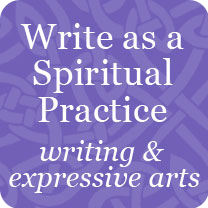 Writing on the Wild Edges: A One-Day Retreat on Writing as a Spiritual Practice
Writing on the Wild Edges: A One-Day Retreat on Writing as a Spiritual Practice
September 19, 2015 in Galway City
Sacred Rhythms: Writing and Movement Retreat in Scotland
February 23-26, 2016 at Bield at Blackruthven
Want to come to Ireland on pilgrimage this October 20-28, 2015?
One space open now. Email Christine to inquire.
The post New Writing Retreats Added appeared first on Abbey of the Arts.
July 11, 2015
Chronic Illness as Pilgrimage (a love note)
Dearest monks, artists, and pilgrims,
I continue my blog book tour this summer and am delighted that Judy Smoot of Always We Begin Again is hosting a guest post from me as well as an interview (see interview details below).
Here is an excerpt of my reflection on living with chronic illness as an experience of pilgrimage:
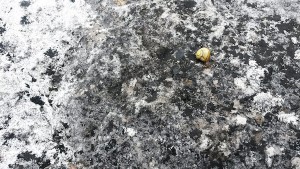 I was first diagnosed with rheumatoid arthritis when I was 21 years old. The only other person I knew at the time with this disease was my mother and her body had been ravaged by the effects of deterioration, with multiple joint replacements and eventually use of an electric wheelchair for mobility.
I was first diagnosed with rheumatoid arthritis when I was 21 years old. The only other person I knew at the time with this disease was my mother and her body had been ravaged by the effects of deterioration, with multiple joint replacements and eventually use of an electric wheelchair for mobility.
I first dealt with my diagnosis through denial. I had just graduated from college and traveled across the country to begin a year of volunteer work. I managed to push my way through fatigue and pain for about six years before I was forced to stop. I was teaching high school at the time and my wrists were growing ever more painful. An xray revealed severe damage to the joints despite the aggressive medication I had been taking.
My doctor urged me to stop teaching, it was too much for my body. Thankfully I had private disability insurance through the school where I worked that helped sustain me financially first through a year of rest and healing and later through five years of graduate work to earn a PhD. I lived much of that time with the fear I would never be able to support myself financially. I was profoundly grateful for my loving husband who worked to provide for our needs.
During that first year of disability, without any work to claim when people asked me “what do you do?”, I was often in emotional pain as well over the loss of an identity. I didn’t look sick and often came judgment from others, or inner judgment about why I wasn’t trying harder. Many were supportive, but others offered unwelcome advice or explanations about how I wasn’t thinking the right thoughts. Dr. Joan Borsyenko describes this as “new age fundamentalism.”
Keep reading my reflection here>>
There are many kinds of journeys in our lives, some are more challenging to others. The invitation is to respond from a place of compassion and welcome to all the discomfort that arises in us in response.
With great and growing love,
Christine
*This note is excerpted from Christine’s book The Soul of a Pilgrim: Eight Practices for the Inner Journey.
The post Chronic Illness as Pilgrimage (a love note) appeared first on Abbey of the Arts.
Chronic Illness as Pilgrimage
Dearest monks, artists, and pilgrims,
I continue my blog book tour this summer and am delighted that Judy Smoot of Always We Begin Again is hosting a guest post from me as well as an interview (see interview details below).
Here is an excerpt of my reflection on living with chronic illness as an experience of pilgrimage:
 I was first diagnosed with rheumatoid arthritis when I was 21 years old. The only other person I knew at the time with this disease was my mother and her body had been ravaged by the effects of deterioration, with multiple joint replacements and eventually use of an electric wheelchair for mobility.
I was first diagnosed with rheumatoid arthritis when I was 21 years old. The only other person I knew at the time with this disease was my mother and her body had been ravaged by the effects of deterioration, with multiple joint replacements and eventually use of an electric wheelchair for mobility.
I first dealt with my diagnosis through denial. I had just graduated from college and traveled across the country to begin a year of volunteer work. I managed to push my way through fatigue and pain for about six years before I was forced to stop. I was teaching high school at the time and my wrists were growing ever more painful. An xray revealed severe damage to the joints despite the aggressive medication I had been taking.
My doctor urged me to stop teaching, it was too much for my body. Thankfully I had private disability insurance through the school where I worked that helped sustain me financially first through a year of rest and healing and later through five years of graduate work to earn a PhD. I lived much of that time with the fear I would never be able to support myself financially. I was profoundly grateful for my loving husband who worked to provide for our needs.
During that first year of disability, without any work to claim when people asked me “what do you do?”, I was often in emotional pain as well over the loss of an identity. I didn’t look sick and often came judgment from others, or inner judgment about why I wasn’t trying harder. Many were supportive, but others offered unwelcome advice or explanations about how I wasn’t thinking the right thoughts. Dr. Joan Borsyenko describes this as “new age fundamentalism.”
Keep reading my reflection here>>
There are many kinds of journeys in our lives, some are more challenging to others. The invitation is to respond from a place of compassion and welcome to all the discomfort that arises in us in response.
With great and growing love,
Christine
*This note is excerpted from Christine’s book The Soul of a Pilgrim: Eight Practices for the Inner Journey.
The post Chronic Illness as Pilgrimage appeared first on Abbey of the Arts.

